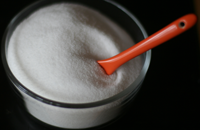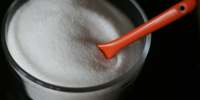The Goods on Glucose
Depending on your age and your weight, you might stop, spoon poised, and fleetingly think twice about your loaded triple-fudge and caramel brownie sundae with extra candy sprinkles—just before you dig in. Whether you finish off the sundae alone or not, it's impossible to escape awareness of the debates that rage on about the nutritional dangers of too much sugar. But it isn't as simple as simply saying "no" to a spoonful of sugar here and there. When it comes to sugar and the body, there's more to consider than just after-dinner dessert or a plate of morning pancakes loaded with syrup. How long it takes the body to process the sugar you take in has a lot to do with how good or bad a food may be for you and your bloodstream. Experimenting with a plant-based enzyme can help students peer inside the digestion process.

For people with diabetes, especially Type 1 Diabetes, the level of glucose in the blood has to be constantly monitored. Too much or too little glucose can lead to health problems, but even people without diabetes need to be aware of blood sugar issues. Understanding how glucose is created in the body—and how sugars in foods are converted to glucose—can make nutritional labels make more sense. How much do you know about sugars? The plant-based enzyme, invertase, helps students look under the lid to see what's going on inside the digestive process.
Opinions vary, but many parents argue that sugar makes their kids hyper, cranky, or less focused. Some adults even admit to post-sugar blues, and while your common approach to an afternoon slump might be to grab a candy bar, nutritionists will tell you that protein is a better choice to rev up a flagging brain. In recent years, sugar has become a pariah for healthy eating advocates, health practitioners, and many parents. In reaction to the outcry against sugar and carbohydrates, numerous fad diets have made the rounds as the public searches for the key to healthy eating.
Unfortunately, there are no easy answers. Most agree that too much sugar isn't good for any of us at any age. That doesn't necessarily mean no sugar. It doesn't necessarily mean eating only protein. It may or may not work out that eliminating all white foods from your diet is a sure-fire approach to nutritional health.
While there are clear culprits in the sugar game and obvious sources of unnecessary sugar overload lining grocery store shelves and household pantries and snack drawers, the reality is that sugar, in all its forms, and combined with overeating and less active lifestyles, has contributed to an increasing number of people who either have Type 2 diabetes and know about it, have Type 2 diabetes and don't yet realize it, or are considered pre-diabetic. Type 2 Diabetes is a metabolic condition in which the body fails to effectively convert glucose to energy.1 The problem centers around the body's production and use of insulin, a hormone produced by the pancreas that helps regulate the level of glucose in the blood.
According to the American Diabetes Association, 25.8 million people in the U.S. have diabetes. That number, which includes both children and adults, represents 8.3% of the U.S. population.2 Complications and conditions caused by, or connected to, diabetes are wide-ranging. Blindness, kidney failure, and heart disease are among the many health conditions linked to diabetes, and diabetes is a factor in more than half of all non-traumatic lower-limb amputations.
The numbers are startling and dramatic, and while the search for a "cure" for big name killers is always on the front burner, diabetes is a silent but far-reaching and growing health problem in the U.S. and comes in at number seven on the Centers for Disease Control and Prevention's (CDC) list of leading causes of death. Treatment for Type 2 Diabetes, in large part, often begins with nutrition, and the more you know about "sugar" and the body, the better. Avoiding refined sugars like those found in a candy bar or lollipop isn't enough. Instead, it's important to understand how the body processes sugars, how long it takes for glucose to clear from the blood stream after eating, and what slows down or speeds up the process.
Glucose in the Body
Sucrose, the white sugar commonly used in baking, is one of several kinds of sugars, all of which are carbohydrates. During digestion, sucrose and other carbohydrates (like starch) are broken down to create glucose and fructose, basic carbohydrates that are then digested and absorbed into the intestines. When glucose is being created from food that has been taken into the body, the level of glucose in the blood rises. It is the pancreas's job to monitor and respond to the blood glucose level. If the level is high, the pancreas releases insulin to instruct cells to remove glucose from the blood and store it for energy; if the blood glucose level drops, the pancreas stops releasing insulin, signaling that the body should use stored glucose. It's a delicate balance. (For someone with Type 1 Diabetes, this balancing act is especially important and requires 24-hour monitoring to ensure blood sugars are kept within certain ranges. Tip the glucose or insulin scales one way or the other, and serious problems can arise.)
While reading labels and monitoring the intake of sugars can help you be more aware of food choices, the rate of digestion of sugars and carbohydrates differs. As a result, the impact of sugars in two different foods may not be the same on the body. Students can't easily monitor digestion and glucose production in a human body, but by using invertase, an enzyme that catalyzes the same reaction in plants and yeast as sucrase does in the human body, students can simulate and explore the breakdown of sugars and what the process reveals about various types of foods.
Invertase in Action
The "Sucrose & Glucose & Fructose, Oh My! Uncovering Hidden Sugar in Your Food" project from the Medical Biotechnology interest area of the Science Buddies Project Ideas Library gives students a blueprint for conducting a biotechnology investigation of the relationship between the concentration of sugars in common foods, the time involved in converting those sugars to glucose, and the amount of glucose digested. Using invertase, students can test various foods to observe, firsthand, glucose concentration levels both before and after the enzyme is added. As a result of this investigation, students will better understand what foods are good when someone needs a glucose boost, what foods convert to glucose faster than others, and which foods have a minimal impact on blood glucose levels. The "How Sweet It Is! Measuring Glucose in Your Food" project offers a less advanced science project that explores glucose concentration in fruits and juices—minus the simulated digestion.
Before you sit down with that next triple fudge sundae, you might give an extra moment of thought to the glucose involved. You may not see it lurking in the cherry on top, but your body views sugar as more than simply a sweet treat. It's a complicated biochemical process, and the more you understand what's going on, the more educated choices you can make!
1. Unlike Type 2 Diabetes, Type 1 Diabetes is an auto-immune disease in which the cells in the pancreas that produce insulin are killed off and the pancreas no longer makes insulin. Individuals with Type 1 Diabetes must take insulin every day to stay alive.
2. Development of the "Sucrose & Glucose & Fructose, Oh My! Uncovering Hidden Sugar in Your Food" project was sponsored by Norvo Nordisk.
* U.S. diabetes statistics are from the National Diabetes Fact Sheet, released January 26, 2011 by the Centers for Disease Control.
Categories:
You Might Also Enjoy These Related Posts:
- Plastics and Earth Day - Science Projects
- Arduino Science Projects and Physical Computing
- 10+ Robotics Projects with the BlueBot Kit
- 5 STEM Activities with Marshmallow Peeps
- March Madness Basketball Science Projects: Sports Science Experiments
- Women in STEM! More than 60 Scientists and Engineers for Women's History Month
- Explore Artificial Intelligence and Machine Learning with Student AI Projects
- 10 Reasons to Do the Rubber Band Car Engineering Challenge










